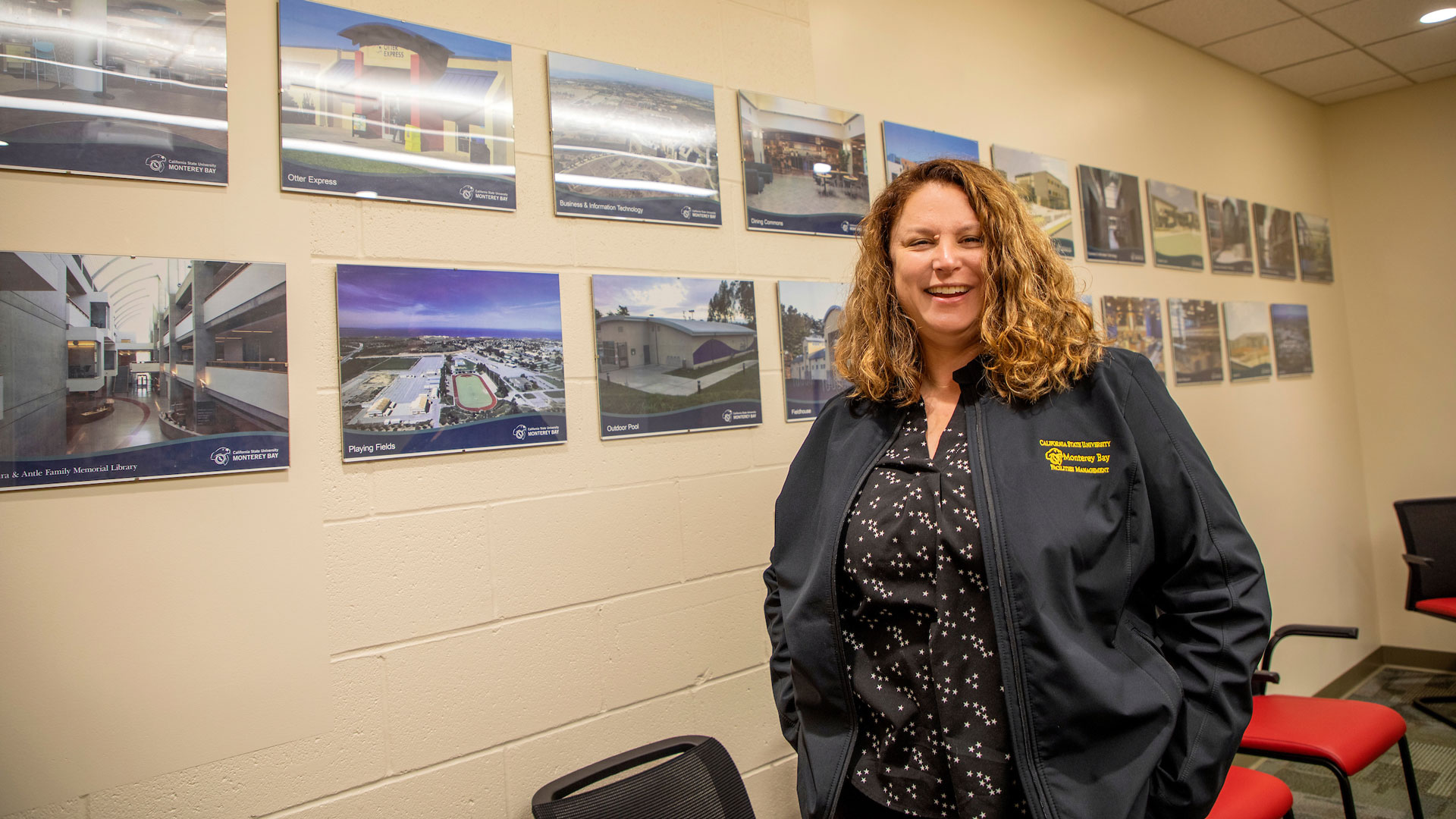CSUMB construction manager paving way for women

Katie LaPlace stands in front of a wall of CSUMB construction project photos from the last 20 years. | Photo by Tatiana Muniz
March 1, 2022
CSUMB’s “Strength Through Diversity” awareness campaign aims to build on our ongoing commitment to inclusive excellence. Stories, social media posts, and special events throughout the academic year will celebrate diversity and highlight the many identity groups represented by the students, faculty, staff, and alumni that make up the CSUMB community. March is Women’s History Month.
By Kera Abraham
Moving every few years as a kid gave Katie LaPlace an early instinct for adaptation. The daughter of an Air Force navigator, she learned to make friends and fit in quickly at each new school.
Today, that resilience is an asset in LaPlace’s role as CSUMB senior construction manager, responsible for planning and overseeing construction projects across campus. Creative problem-solving is LaPlace’s M.O., according to her colleague Stacey Hadland, a CSUMB space and move specialist.
“Even the best-planned construction projects often present unforeseen issues,” Hadland says. “Katie's years of experience and institutional knowledge enable her to quickly assess the issue and provide a workable solution.”
Brainpower like LaPlace’s is critical in a field that requires technical expertise, innovation, and vision. But in a U.S. workforce that’s 47 percent women, construction is one of the most male-dominated industries. According to the U.S. Bureau of Labor Statistics, women comprise only 11 percent of construction workers. The ratio is more balanced at CSUMB, where the Planning and Development team, including consultants, is currently made up of five women and 10 men.
“When I first started my career, it was very similar to all the stereotypes,” LaPlace says. “I had to learn early how to handle the situations differently and show confidence in my role. Once many of my male counterparts saw that I knew what I was doing, they tended to treat me as an equal.”
The industry has changed over the years, she adds: “The Me Too movement brought a lot of change in attitudes and broke the habits of folks who had learned bad behavior within the construction environment.”
As an undergraduate at California Polytechnic State University, LaPlace majored in structural engineering with a minor in construction management. Her career path took her from a heavy civil contractor, where she helped engineer multi-state cyber network infrastructure, to a construction management company, where she helped execute projects on college campuses. LaPlace came to CSUMB in 2002 as a consultant; five years later, the university brought her on as an employee.
When LaPlace joined the CSUMB team in 2007, one of the most daunting construction goals was, ironically, building removal. The campus sits on the former Fort Ord Army base, a major location for basic training from the 1950s to 1970s. Bunkers and other buildings from Fort Ord’s heyday were classified as blight, too hazardous to use and a challenge to safely remove.
“The age of the Army structures resulted in a large amount of hazardous materials that were typical for construction at that time,” LaPlace says. “This required specialized contractors to perform the removal safely.”
In 2015, LaPlace and her team were charged with the removal of military housing between Sixth and Seventh avenues. The first two demolitions were more difficult and costly than anticipated – and the team still had 19 of the three-story homes to go.
So LaPlace, in consultation with the Chancellor’s Office and procurement team, proposed an unconventional approach: instead of soliciting bids on entire project phases, the team selected three contractors to perform partial abatement in one building for a month.
“This allowed each contractor to understand what it would take to execute the full scale of the project,” LaPlace says. “It was great to have a team at the Chancellor’s Office and on campus to support thinking outside of the box.”
With the experience under their belts, the contractors were invited to bid on the project’s multiple phases, which resulted in the successful removal of all 19 homes over three years – and transformed the eastern portion of campus into open space, with the potential for future growth.
The California State University recently launched the Women in Facilities program to provide information, networking, and mentoring for women pursuing facilities management careers. The four-month program kicked off in January with a pilot cohort of 12 women in facilities management roles across the CSU system.
Amy Forte, director of administration at the Chancellor’s Office, created the program along with three other women in CSU facilities. Forte says if the pilot is successful, they’ll roll the program out to additional staff; LaPlace hopes to participate in a future cohort.
“Women tend to be underrepresented in higher-level leadership roles,” Forte says. “We want to bring about change in this space.”